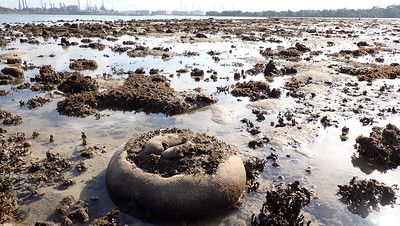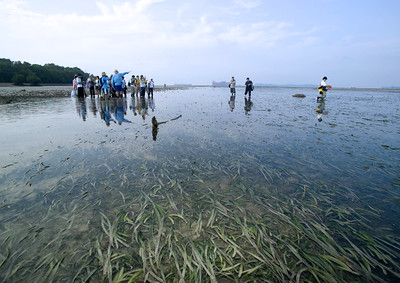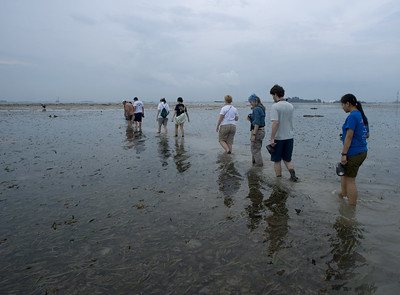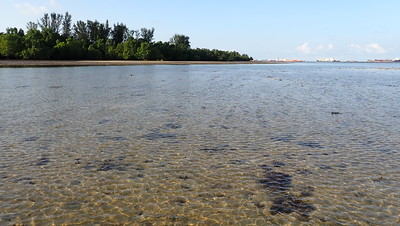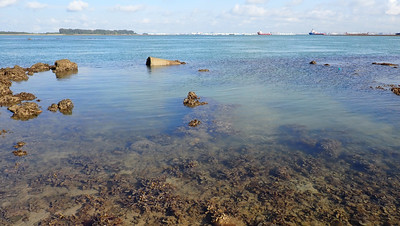We were glad to see Knobbly sea stars which used to delight our visitors. Kok Sheng found a Giant clam! Kelvin saw a sea turtle from the drone. The corals are doing well and we see the usual marine life. Sharks and sea turtles are spotted too. Unfortunately, the seagrasses remain sparse on the shore.
The star of the intertidal walk in the past were Knobbly sea stars. It was great to see 8 of them near the reef edge. Although in the past they were more plentiful.
Kok Sheng found a Giant clam with an unusual spotted body pattern. He also makes all the special finds as usual. An anemonefish and special anemones - Leathery sea anemones and Pizza anemones. Also some less common corals as well as a Cushion sea star. See his album for more photos.
 |
| Photos by Loh Kok Sheng. |
I have not seen a lot of hard corals on this stretch of shores in the past. Today, it remains the same. There are a few large corals, mostly boulder shaped. They seemed alright.
At the reef edge there were a few colonies of special corals such as Cabbage coral, Lettuce coral and Trumpet coral. The usual common corals were also there. I didn't see any extensive bleaching.
Near the reef edge, I saw many small to medium-sized Leathery soft corals of various kinds. I didn't see any that were bleaching.
At the reef edge there were a few colonies of special corals such as Cabbage coral, Lettuce coral and Trumpet coral. The usual common corals were also there. I didn't see any extensive bleaching.
Near the reef edge, I saw many small to medium-sized Leathery soft corals of various kinds. I didn't see any that were bleaching.
There used to be a large meadow of long Tape seagrass in a long shallow lagoon here. Here's what it looked like when TeamSeagrass started monitoring the seagrasses here in 2007.
The highlight of the public walk in the past was walking through thick growths of very long Tape seagrass, as in this photo taken in 2008.
Today, the middle of the shallow lagoon was almost completely bare, with very few clumps of Tape seagrasses, all were cropped. Similar to what we saw on our last survey in Jan 2021,
At the mid-water mark near the high shore, there were sprinkles of Spoon seagrass (small leaves) and Sickle seagrass, all heavily covered in epiphytes. At the reef edge, I did see small clumps of Tape seagrasses with longer leaves (about 30cm).The highlight of the public walk in the past was walking through thick growths of very long Tape seagrass, as in this photo taken in 2008.
Today, the middle of the shallow lagoon was almost completely bare, with very few clumps of Tape seagrasses, all were cropped. Similar to what we saw on our last survey in Jan 2021,
Despite the lack of seagrasses, there were still some animals in the shallow lagoon. I saw many Giant carpet anemones (no anemonefish though), a Noble volute laying an egg capsule, some clumps of Branching montipora corals and the usual assortment of sponges.
Thanks to Kelvin's drone video, we can see there is virtually no seagrass north of the canal (left in the photo), while there is some green stuff south of the canal (right in the photo).
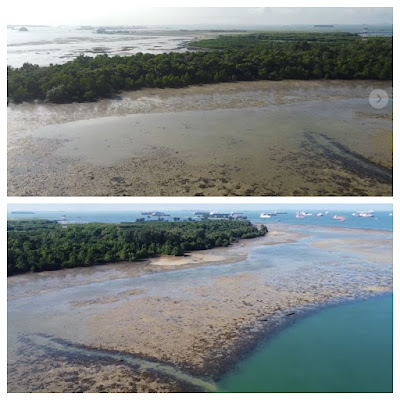 |
| Stills from Kelvin's drone video |
On the ground, this is the green stuff that I saw in the area: sprinkles of Spoon seagrass and Sickle seagrass, heavily covered in epiphytes. I didn't see any long Tape seagrass.
Here's a comparison of the extent of seagrass cover (dark margin along the mid water mark) in 2008 and 2020 from Google Earth.
Public walks at Pulau Semakau
I got to know this part of Pulau Semakau well when I started the public walk programme here in 2005. I returned in Jan 2021, the first time since Apr 2016.
I believe you can still join a guided intertidal walk at Pulau Semakau today. Contact the Lee Kong Chian Natural History Museum or Strix Wildlife Consultancy for more details.
More about Pulau Semakau
Just as Changi Airport and Changi Beach are not the same even though they are near one another and share a name, Pulau Semakau is NOT the same as the Semakau Landfill. The Landfill was created by destroying all of Pulau Saking, and about half of the original Pulau Semakau by building a very long seawall. Fortunately, the landfill was constructed and is managed in such a way that the original mangroves, seagrass meadows and reefs on Pulau Semakau were allowed to remain. It is NOT true that the construction of the Landfill created the marine life found on Pulau Semakau. The marine life was there long before the Landfill was built.
Photos by others on this trip
Loh Kok Sheng
Kelvin Yong's drone video
Kelvin's photos
Others on this trip: Jonathan Tan.




